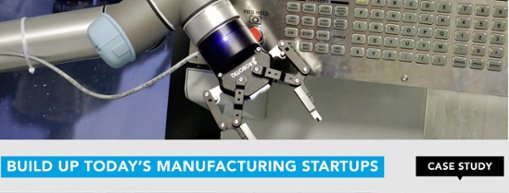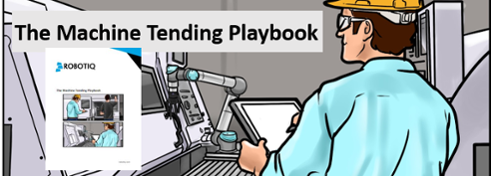How to Add a Robot to Your CNC Machine?

Posted on Jan 15, 2018 7:00 AM. 2 min read time
Machine tending is the process of routinely perform maintenance and checks on robots to ensure that materials are continuously supplied, and that the robot is functioning to the standards it was designed for.
Today’s eBook from the Robotiq marketplace discusses the ways to improve your CNC machine production through the addition of a robot. We’ll cover the major points of the book and show you how much information is waiting at the click of a button!
Reviewing the Machine Tending Playbook
The eBook begins by examining the anatomy of a machine tending cell. It all begins with the CNC machine itself, which stands for “Computer Numerical Control” that can autonomously machine parts. There are nine elements of the cell outlined here.
The following sections discuss a six step plan:
● Estimate Your Production
● Starting Point
● Process Analysis
● Redesign Your Process
● Optimize Your Downtime
● Return on Investments
It all begins with tracking your production. The eBook discusses production rate, spindle time, quantity of defective parts, and more in this first section. It helps you build an excel spreadsheet to track these metrics so you can create graphs and charts that help you see how machine tending is impacting your productivity.
The next section discusses topics like an automated vise, actuated doors, I/O available communications, and measuring parts with a probe. You’ll start by analyzing your human operator’s tending process to anticipate how the robot will be used.
Next up, is process analysis. In this section the eBook discusses expectations around robots and their limitations. Limitations like reach, payload, Gripper dexterity, stroke, and intelligence are all discussed here. Ultimately, process analysis is about translating current manual operation into automated robotic manipulation. Keeping things as simple as possible is always the best approach.
The next step is redesigning the process to meet the limitations of the robot and create a smooth system. With this step, it’s important to remember that some things which are easy for humans, aren’t easy for robots. The idea here is to create a robotic cell that is “bulletproof” in the sense that it will work smoothly beside a CNC machine.
The next step is optimizing downtime. When the CNC machine is running, there will be some free time you can use to be ready for the next part or to eliminate a second operation. Now that a robot is tending the CNC, you can be free to plan ahead.
Finally, there’s the return on investment. While there is another, more suited, Robotiq eBook mentioned here, the topic is still discussed. The recommendation is to use a time-based calculation for ROI, thus presenting an easy to understand model for how the project will show its results.
Machine tending is a process that manufacturers can automate for big returns in time and efficiency. By following these steps, they can integrate a new robotic cell and calculate how long it will take to see a return on the investment.
Have you checked out this awesome eBook? Let us know in the comments!

.jpg?width=640&name=2F85-Wrist-Camera-Machine-Tending-Walt-Machine-41%20(4).jpg)



Leave a comment